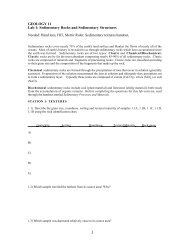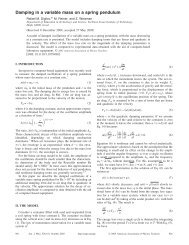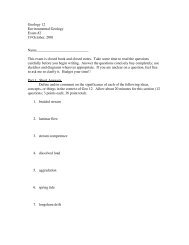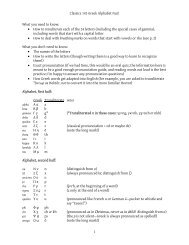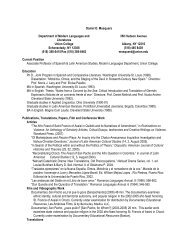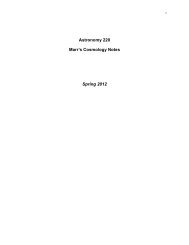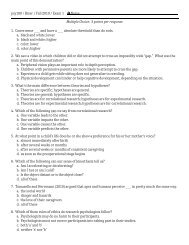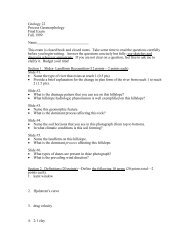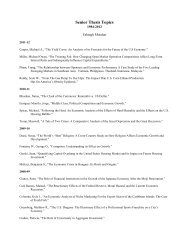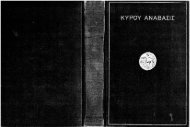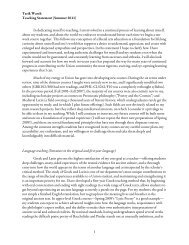Three Meters of Aristophanic Dialogue
Three Meters of Aristophanic Dialogue
Three Meters of Aristophanic Dialogue
You also want an ePaper? Increase the reach of your titles
YUMPU automatically turns print PDFs into web optimized ePapers that Google loves.
III. Anapestic tetrameter catalectic<br />
This is a chanted meter especially associated with the opposing speeches in a debate scene<br />
(agōn) and the parabasis (speech in which the chorus addresses the audience).<br />
Anapest (foot): ˘ ˘ ¯<br />
Anapestic meter is varied, not by resolution, but by allowing substitutions <strong>of</strong> dactyls or<br />
spondees for anapests.<br />
Dactyl (foot): ¯ ˘ ˘<br />
Spondee (foot): ¯ ¯<br />
The anapestic metron consists <strong>of</strong> two feet (like the iambic and trochaic metra), with all three<br />
possibilities allowed in each foot.<br />
Anapestic metron [A]: ˘ ˘ ¯ ˘ ˘ ¯ with any pairing <strong>of</strong> anapests,<br />
¯ ˘ ˘ ¯ ˘ ˘ dactyls, and spondees allowed<br />
¯ ¯ ¯ ¯<br />
As in iambic (and trochaic) meter, even with all the possible substitutions, a ˘˘˘˘ foot is not<br />
allowed (Birds 688, in the example below, is a rare exception). In this meter, the ˘˘˘˘ sequence<br />
is also prohibited across two feet (i.e., dactyl + anapest).<br />
Using A to designate the anapestic metron, the full scheme <strong>of</strong> anapestic tetrameter catalectic is:<br />
A ⁞ A ⁞ A ˘ ˘ ¯ ¯<br />
Again, the first foot <strong>of</strong> the final metron requires a true anapest, to keep the verse form<br />
intelligible. There is regularly a diaeresis after the second metron, and usually also after the<br />
first metron.<br />
EXAMPLES from Birds<br />
How to recognize it: These lines are long! (And the ending ˘ ˘ ¯ ¯ is distinctive.)<br />
685 ᾰγε̆ δη̄ φῠσῐν ᾱνδρε̆ς ᾰμαῡρο̆βῐοῑ, ⁞ φῡλλω̄ν γε̆νε̆ᾱͅ προ̆σο̆μοῑοῑ,<br />
ο̆λῐγο̄δρᾰνε̆ε̄ς, ⁞ πλᾱσμᾰτᾰ πη̄λοῡ, ⁞ σκῐο̆εῑδε̆ᾰ φῡλ’ ᾰμε̆νη̄νᾱ, epic scansion: ο̄δρ (mute+liq.)<br />
ᾱπτη̄νε̆ς ε̆φη̄με̆ρῐοῑ τᾰλᾰοῑ ⁞ βρο̆τοῐ ᾱνε̆ρε̆ς εῑκε̆λο̆νεῑροῑ, epic correption: βρο̆τοῐ ᾱνε̆ρε̆ς<br />
προ̆σε̆χε̆τε̆ το̄ν νοῡν ⁞ τοῑς ᾱθᾰνᾰτοῑς ⁞ η̄μῑν, τοῑς αῑε̆ν ε̆οῡσῑν,<br />
τοῑς αῑθε̆ρῐοῑς, ⁞ τοῑσῐν ᾰγη̄ρῳ̄ς, ⁞ τοῑς ᾱφθῐτᾰ μη̄δο̆με̆νοῑσῑν,<br />
foot 1 irreg. resolved: προ̆σε̆χε̆τε̆<br />
690 ῐν’ ᾰκοῡσᾱντε̄ς ⁞ πᾱντᾰ πᾰρ’ η̄μω̄ν ⁞ ο̄ρθω̄ς πε̆ρῐ τω̄ν με̆τε̆ω̄ρω̄ν,<br />
φῠσῐν οῑω̄νω̄ν ⁞ γε̆νε̆σῑν τε̆ θε̆ω̄ν ⁞ πο̆τᾰμω̄ν τ’ ε̆ρε̆βοῡς τε̆ Χᾰοῡς τε̄<br />
692 εῑδο̆τε̆ς ο̄ρθω̄ς, ⁞ Προ̆δῐκῳ̄ πᾰρ’ ε̆μοῡ ⁞ κλᾱεῑν εῑπη̄τε̆ το̆ λοῑπο̄ν.<br />
Further reading<br />
For more on these meters, see D.S. Raven, Greek Metre: An Introduction, London, 1962, whose<br />
information I have adapted in places above.<br />
© 2007 Tarik Wareh<br />
4



